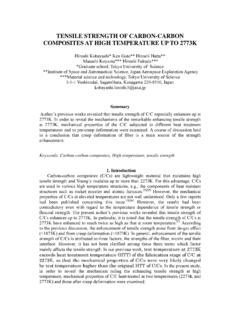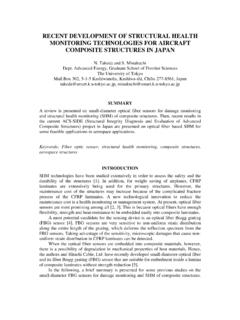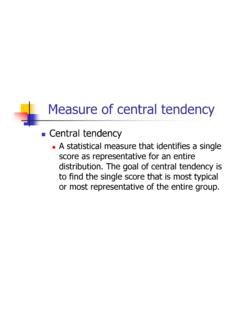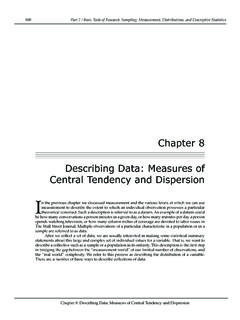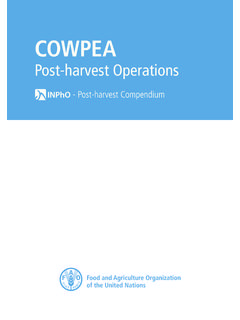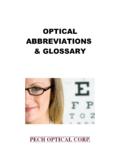Transcription of Tensile and Flexural Properties of Single Carbon …
1 Tensile and Flexural Properties of Single Carbon Fibres Naito K *, Tanaka Y *, Yang JM **, Kagawa Y ** * National Institute for Materials Science 1-2-1 Sengen, Tsukuba, Ibaraki, 305-0047 ** University of California, Los Angeles Los Angeles, CA, 90095-1595 ** The University of Tokyo 4-6-1 Komaba, Meguro-ku, Tokyo, 153-8904 SUMMARY The Tensile and Flexural Properties and fracture behaviour of ultrahigh/high strength and high modulus PAN-based (T1000GB, T300 and M60JB), ultrahigh modulus pitch-based (K13D) and high ductility pitch-based (XN-05) Carbon fibres have been investigated. The statistical distributions of the Tensile and Flexural strength were characterized. Keywords: Tensile , Flexural , Strength, Carbon Fibre, Weibull INTRODUCTION Polyacrylonitrile (PAN)- and pitch-based Carbon fibres are widely used as a reinforcement in composite materials such as Carbon fibre reinforced plastics, Carbon fibre reinforced ceramics, Carbon - Carbon composites and Carbon fibre reinforced metals, because of their high specific strength and modulus.
2 Such composites have become a dominant material in the aerospace, automotive and sporting goods industries [1-3]. Currently, Carbon fibres are derived from several precursors, with polyacrylonitrile (PAN) being the predominant precursor used today. The physical and mechanical Properties of Carbon fibres vary according to the precursor material and heat treatment conditions. PAN-based Carbon fibres generally have high strength, high modulus and low density ( g/cm3). Carbon fibres can also be made from pitch and pitch-based Carbon fibres tend to have high modulus, high thermal and electrical conductivities [4]. Extensive work has been conducted to study the texture, morphology and mechanical Properties of PAN- and pitch-based Carbon fibres [5-7]. The trends toward the development of Carbon fibres have been driven in two directions; high strength fibres with very high Tensile strength and a fairly high strain to failure (~2 %) and high modulus fibre with very high stiffness.
3 Today, a number of ultrahigh strength (more than 6 GPa) PAN-based and ultrahigh modulus (more than 900 GPa) pitch-based Carbon fibres have been commercially available. However, the mechanical Properties of these ultrahigh strength and ultrahigh modulus Carbon fibres have not yet been well documented. In the present work, the Tensile and Flexural tests of Single filaments for commercially available ultrahigh strength PAN-based, ultrahigh modulus pitch-based and high ductility pitch-based Carbon fibres were performed to evaluate the potential of them. The Tensile and Flexural test of high strength and high modulus PAN-based Carbon fibres were also performed for comparison. The Weibull distributions of the Tensile and Flexural strength were evaluated. EXPERIMENTAL Materials Carbon fibres used in this study were an ultrahigh strength PAN-based (T1000GB), an ultrahigh modulus pitch-based (K13D) and a high ductility pitch-based (XN-05) Carbon fibres.
4 A high strength PAN-based (T300) and high modulus PAN-based (M60JB) Carbon fibres were also tested for comparison. PAN-based Carbon fibres were supplied from Toray Industries, Inc. The XN-05 pitch-based Carbon fibres were supplied from Nippon Graphite Fiber Corp. and the K13D pitch-based Carbon fibre was supplied from Mitsubishi Plastics, Inc. All the as-received fibres had been subjected to commercial surface treatments and sizing (epoxy compatible sizing). Specimen Preparation Single filament Carbon fibre specimens were prepared on the stage with the help of a stereoscope. A Single filament was selected from Carbon fibre bundles and cut perpendicular to the fibre axis by a razor blade. All specimens were stored in a desiccator at 20 3 C and at 10 5 % relative humidity prior to testing. Tensile Test Tensile tests of Single Carbon fibres were performed using a universal testing machine (Shimadzu, Table top type tester EZ-Test) with a load cell of 10 N.
5 The Tensile specimen was prepared by fixing the filament on a paper holder with an instant cyanoacrylate adhesive, as reported elsewhere [8, 9]. The specimen was set up to the testing machine. The holder was cut into two parts, before testing. The gauge length of 25 mm and crosshead speed of mm/min were applied. All tests were conducted under the laboratory environment at room temperature (at 23 3 C and 50 5 % relative humidity). Twenty specimens were tested for all Carbon fibres. Tensile Properties were determined according to ASTM D3379 [8]. Flexure Test Three point bending tests of Single Carbon fibres were performed on a test fixture with X-Y stage and razor blade supports (radius of curvature was 600 nm) using a universal testing machine (Shimadzu, Table top type tester EZ-Test) with a micro-load cell of 50 mN (Kyowa, LVS-5GA) and the load was introduced using a razor blade.
6 In this study, the span length of 200 m was used. Specimens were placed on razor blade supports and a load was applied quasi-statically at a crosshead speed of mm/min. All tests were conducted under the laboratory environment at room temperature (at 23 3 C and 50 5 % relative humidity). Twenty specimens were tested for all Carbon fibres. Fracture Surface Observation After testing, fracture surfaces of the Carbon fibres were examined using a JSM 6500F field emission scanning electron microscope (SEM). RESULTS AND DISCUSSIONS Tensile Test Figure 1 shows typical Tensile stress-strain ( - ) curves for ultrahigh strength PAN-based (T1000GB), ultrahigh modulus pitch-based (K13D), high ductility pitch-based (XN-05), high strength PAN-based (T300) and high modulus PAN-based (M60JB) Carbon fibres from Single fibre Tensile testing. Figure 1 Typical Tensile stress-strain curves for PAN- and pitch-based Carbon fibres.
7 For the T1000GB and K13D fibres, the stress applied to the specimen was almost linearly proportional to the strain until failure. Similar linear stress-strain behavior was observed in the T300 and M60JB fibres. However, for the XN-05 fibre, the stress-strain curve was shown slightly non-linear. The average Tensile modulus (Ef), strength ( f) and failure strain ( f) were shown in Table 1. The results showed that the T1000GB fibre has an average Tensile strength of GPa. The K13D fibre has an average Tensile modulus of 940 48 GPa. The XN-05 fibre has a failure strain of % although the Tensile modulus and strength are quite low. Table 1 Physical Properties of PAN- and pitch-based Carbon fibres. PAN-based Pitch-based Fibre T1000GB T300 M60JB K13D XN-05 Tensile modulus Ef (GPa) 291 (11) 221 (13) 521 (37) 940 (48) 41 (2) Tensile strength f (GPa) ( ) ( ) ( ) ( ) ( ) Failure strain f (%) ( ) ( ) ( ) ( ) ( ) Flexural strength f (flexure) (GPa) ( ) ( ) ( ) ( ) ( ) Flexure Test Figure 2 shows typical load-deflection (P - ) curves for ultrahigh strength PAN-based (T1000GB), ultrahigh modulus pitch-based (K13D), high ductility pitch-based (XN-05), high strength PAN-based (T300) and high modulus PAN-based (M60JB) Carbon fibres.
8 The load was almost linearly proportional to the deflection at the beginning of loading (linear deformation region). Subsequently, a transition from linear to nonlinear deformation occurred with an increase in applied load until the load reached its maximum. Afterwards, the load decreased gradually with an increase in deflection until fracture of the fibre occurred. Figure 2 Typical load-deflection curves for PAN- and pitch-based Carbon fibres The Flexural stress for the three point bending test was calculated based on a simple beam theory and the Flexural strength, f (flexure) of these Carbon fibres is defined as maximum Flexural stress. The Flexural strength, f (flexure) for these Carbon fibres was also shown in Table 1. The Flexural strengths of the T1000GB, XN-05, T300 and M60JB fibres are higher than their Tensile strength. However, the Flexural strength of the K13D fibre is lower than its Tensile strength.
9 Weibull Modulus The results shown in Table 1 clearly indicate that there is an appreciable scattering of Tensile and Flexural strength. The statistical distribution of fibre strengths is usually described by means of the Weibull equation [10]. The two-parameter Weibull distribution is given by =imiFexpP01 (1) where PF is the cumulative probability of failure of a Carbon fibre at applied Tensile or Flexural strength i, mi is the Weibull modulus (Weibull shape parameter) of the Carbon fibre, 0 a Weibull scale parameter (characteristic stress). Consequently, rearrangement of the two-parameter Weibull statistical distribution expression gives the following: ()()011 lnmlnmPlnlniiiF = (2) Hence the Weibull modulus, mi can be obtained by linear regression from a Weibull plot of Eq. (2). Figure 3 shows the Weibull plots of ultrahigh strength PAN-based (T1000GB), ultrahigh modulus pitch-based (K13D), high ductility pitch-based (XN-05), high strength PAN-based (T300) and high modulus PAN-based (M60JB) Carbon fibres.
10 The Weibull modulus of the Tensile strength for the T1000GB, K13D, XN-05, T300 and M60JB fibres were calculated to be , , , and , respectively ( (a)). The results clearly show that the K13D Carbon fibre has the lowest Weibull modulus of the Tensile strength and fracture strain, while the XN-05 Carbon fibre has the highest Weibull modulus of the Tensile strength and fracture strain. The Weibull modulus of the Flexural strength for the T1000GB, K13D, XN-05, T300 and M60JB fibres were calculated to be , , , and , respectively. The results clearly show that the Weibull modulus of the Flexural strength is similar among the three Carbon fibres. Obviously, the Weibull modulus under the Flexural test is higher than that obtained under the Tensile test. (a) Tensile strength (b) Flexural strength Figure 3 Weibull plots for PAN- and pitch-based Carbon fibres.
